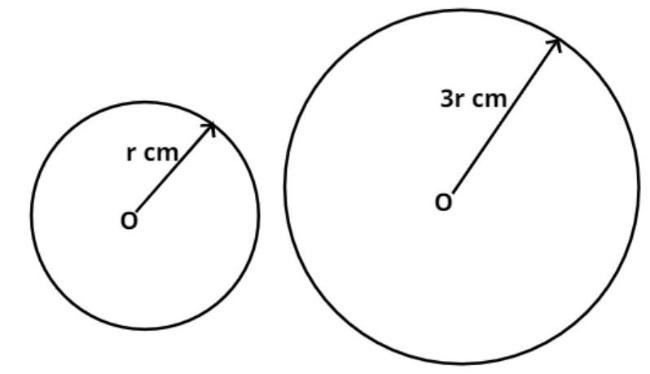
A circle of radius 7 cm is scaled 3 times. Then the perimeter of the circle become:
$\left( A \right)$ 3 times the original perimeter.
$\left( B \right)$ 6 times the original perimeter.
$\left( C \right)$ 9 times the original perimeter.
$\left( D \right)$ Doesn’t change.


Answer
585k+ views
Hint – In this particular question use the concept that a circle is a 2-D figure so the perimeter of the circle is equal to the circumference of the circle so use this concept to reach the solution of the question.
Complete step-by-step answer:
Given data:
Circle having radius 7 cm.
Let the radius of this circle be denoted by r cm (as shown in the figure).
Therefore, r = 7 cm.
Now it is given that the radius of the circle is scaled by 3 times.
So the new radius of the circle is 3 times the previous radius of the circle.
Let the new radius of the circle be denoted by R.
Therefore, R = 3r cm (as shown in the figure).
Now as we know that the perimeter of any shape is the sum of all the side lengths of the shape.
In the case of the circle as a circle is a 2-D figure so the perimeter of the circle is the circumference of the circle.
Now we all know that the circumference of the circle is given as $\left( {2\pi r} \right)$
So the circumference/perimeter of the smaller circle having radius r is
$ \Rightarrow {C_1} = 2\pi r$cm
$ \Rightarrow {C_1} = 2 \times \dfrac{{22}}{7} \times 7 = 44$ cm.................. (1)
Now the circumference/perimeter of the bigger circle having radius 3r is
\[ \Rightarrow {C_2} = 2\pi \left( {3r} \right)\]cm
Now simplify this we have,
\[ \Rightarrow {C_2} = 3\left( {2\pi r} \right)\].................. (2)
Now from equation (1) and (2) we have,
\[ \Rightarrow {C_2} = 3\left( {44} \right) = 132\] Cm.
So the perimeter of the circle whose radius is scaled three times the radius of the original circle is also three times the original perimeter.
So this is the required answer.
Hence option (A) is the correct answer.
Note – Whenever we face such types of questions the key concept we have to remember is that always recall the formula of the circumference of the circle which is stated above, then first calculate the circumference of the smaller circle as above then calculate the circumference of the bigger circle then check the circumference/perimeter of the bigger circle is how much times the original perimeter which is the required answer.
Complete step-by-step answer:
Given data:
Circle having radius 7 cm.
Let the radius of this circle be denoted by r cm (as shown in the figure).
Therefore, r = 7 cm.
Now it is given that the radius of the circle is scaled by 3 times.
So the new radius of the circle is 3 times the previous radius of the circle.
Let the new radius of the circle be denoted by R.
Therefore, R = 3r cm (as shown in the figure).
Now as we know that the perimeter of any shape is the sum of all the side lengths of the shape.
In the case of the circle as a circle is a 2-D figure so the perimeter of the circle is the circumference of the circle.
Now we all know that the circumference of the circle is given as $\left( {2\pi r} \right)$
So the circumference/perimeter of the smaller circle having radius r is
$ \Rightarrow {C_1} = 2\pi r$cm
$ \Rightarrow {C_1} = 2 \times \dfrac{{22}}{7} \times 7 = 44$ cm.................. (1)
Now the circumference/perimeter of the bigger circle having radius 3r is
\[ \Rightarrow {C_2} = 2\pi \left( {3r} \right)\]cm
Now simplify this we have,
\[ \Rightarrow {C_2} = 3\left( {2\pi r} \right)\].................. (2)
Now from equation (1) and (2) we have,
\[ \Rightarrow {C_2} = 3\left( {44} \right) = 132\] Cm.
So the perimeter of the circle whose radius is scaled three times the radius of the original circle is also three times the original perimeter.
So this is the required answer.
Hence option (A) is the correct answer.
Note – Whenever we face such types of questions the key concept we have to remember is that always recall the formula of the circumference of the circle which is stated above, then first calculate the circumference of the smaller circle as above then calculate the circumference of the bigger circle then check the circumference/perimeter of the bigger circle is how much times the original perimeter which is the required answer.
Recently Updated Pages
Master Class 12 Business Studies: Engaging Questions & Answers for Success

Master Class 12 Economics: Engaging Questions & Answers for Success

Master Class 12 English: Engaging Questions & Answers for Success

Master Class 12 Maths: Engaging Questions & Answers for Success

Master Class 12 Social Science: Engaging Questions & Answers for Success

Master Class 12 Chemistry: Engaging Questions & Answers for Success

Trending doubts
Who was the first woman to receive Bharat Ratna?

Write a letter to the principal requesting him to grant class 10 english CBSE

Why is there a time difference of about 5 hours between class 10 social science CBSE

What is the median of the first 10 natural numbers class 10 maths CBSE

The Equation xxx + 2 is Satisfied when x is Equal to Class 10 Maths

Discuss the main reasons for poverty in India




